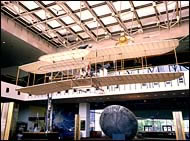![]()
NOTE: This aircraft has been moved to The Wright Brothers & The Invention of the Aerial Age exhibition. On December 17, 1903, at Kitty Hawk, North Carolina, the 1903 Wright Flyer became the first powered, heavier-than-air machine to achieve controlled, sustained flight with a pilot aboard. It flew forward without losing speed and landed at a point as high as that from which it started. With Orville Wright as pilot, the airplane took off from a launching rail and flew for 12 seconds and a distance of 37 meters (120 feet). The airplane was flown three more times that day, with Orville and his brother Wilbur alternating as pilot. The longest flight, with Wilbur at the controls, was 260 meters (852 feet) and lasted 59 seconds. The Flyer, designed and built by the Wright brothers, was one step in a broad experimental program that began in 1899 with their first kite and concluded in 1905, when they built the first truly practical airplane. The basic problems of mechanical flight, lift, propulsion, and control were solved in the Wright design.
The 1903 Wright Flyer was constructed of spruce and ash covered with muslin. The framework "floated" within fabric pockets sewn inside, making the muslin covering an integral part of the structure. This ingenious feature made the aircraft light, strong, and flexible. The 1903 Flyer was powered by a simple four-cylinder engine of the Wrights' own design. To fly the airplane, the pilot lay prone with his head forward, his left hand operating the elevator control. Lateral control was achieved by warping the wing tips in opposite directions via wires attached to a hip cradle mounted on the lower wing. The pilot shifted his hips from side to side to operate the mechanism, which also moved the rudder.
More Information:
|
|||||||||||||||||||||
![]() Milestones
of Flight | 1926 Goddard Rocket
Milestones
of Flight | 1926 Goddard Rocket
![]()
©National Air and Space Museum


